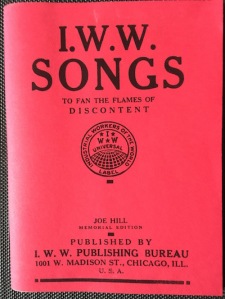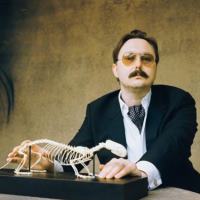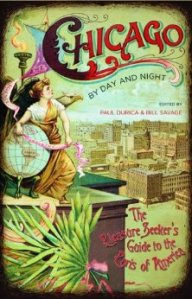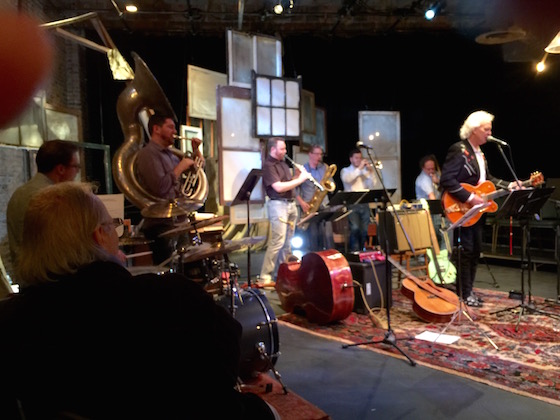Celebrating the life and music of Joe Hill, executed 100 years ago
Posted: December 2, 2015 Filed under: Chicago, Music, Politics | Tags: Big Shoulders Brass Band, Bucky Halker, Filament Theatre, Jon Langford, Pocket Guide to Hell, Sally Timms, The HIdeout Leave a commentSongwriter and labor activist Joe Hill was executed in Salt Lake City on November 19, 1915, framed for a crime he didn’t commit. Because he didn’t “want to be found dead in Utah,” his body was transported to Chicago by the IWW (the Industrial Workers of the World or Wobblies). His last will included the famous entreaty, “Don’t Mourn But Organize.”
Some 30,000 people viewed the funeral procession and attended the lively funeral service at the West Side auditorium (Racine and Harrison) on that November 25 (Thanksgiving Day) and his body was cremated at Graceland Cemetery. What happened to his ashes? That’s another whole story.
 Chicago fans of Joe Hill, a Swedish-born itinerant laborer, celebrated the anniversary of his life and music on several occasions in November. I attended two excellent events, highlighted by great performances of Joe’s music. He wrote dozens of songs that lambasted capitalism and bosses, but his most famous lyric was “You’ll get pie in the sky when you die.”
Chicago fans of Joe Hill, a Swedish-born itinerant laborer, celebrated the anniversary of his life and music on several occasions in November. I attended two excellent events, highlighted by great performances of Joe’s music. He wrote dozens of songs that lambasted capitalism and bosses, but his most famous lyric was “You’ll get pie in the sky when you die.”
The Hideout, a 19th century working men’s saloon on Wabansia, was standing room only the night of the main Joe Hill celebration. My Gapers Block story describes the agenda and list of speakers, which included a funeral oration by Larry Spivack of the Illinois Labor History Society and a rousing description of today’s IWW by Alison Olhava and Randall Jamrok. (The IWW is organizing successfully today, with branches at companies like Jimmy John’s, Starbucks and Pizza Hut. See their website for other industries and companies where the union is active.)
The evening started with a rousing set including “The Preacher and the Slave” by Bucky Halker and his amazing guitar, and closed with songs by a group including Jon Langford and Sally Timms of the Mekons and Martin Billheimer on accordion. Their closing number was “Workers of the World Awaken,” in which the crowd joined in. Psalm One and Fluffy performed a terrific hiphop version of Hill’s “Rebel Girl.”
A funeral march and procession closed the evening and Joe Hill’s coffin was carried outside by pallbearers and burned over a bonfire. The ashes were our burned notes describing why we believe Joe Hill lives today. Anyone who wanted to replicate the 1915 distribution of ashes had only to leave a self-addressed envelope. (In 1915, Joe’s ashes were divided up into a bunch of small envelopes with his picture on the front with the caption, “Murdered by the capitalist class.” The envelopes were given to IWW delegates and guests so Joe’s ashes could be scattered in every state except Utah and in other countries too.)
Bucky Halker, a singer-songwriter and PhD in labor history from the University of Minnesota, just released his new album, Anywhere But Utah: The Songs of Joe Hill, at an album release party at the Filament Theatre in the Six Corners neighborhood. Bucky played with the Big Shoulders Brass Band, featuring two saxophones, trumpet, tuba, trombone and drums. John Abbey sat in on upright bass on several numbers. Bucky and the band played two sets, including “Scissor Bill,” and concluded with a procession around the theater.
Here’s Bucky performing the Joe Hill song from the Little Red Song Book of IWW Songs.
October madness: Too much, too much
Posted: October 20, 2013 Filed under: Art & architecture, Movies | Tags: Armory Show, cats, Hannah Arendt, Pocket Guide to Hell, Siskel Film Center 1 CommentThis is madness! Chicago Ideas Week. Open House Chicago. Chicago Humanities Festival. Chicago International Film Festival. SOFA Chicago. The Internet Cat Video Film Festival.*
How can all these fabulous activities be happening in one month? There are at least five or six other months in Chicago when timid tourists would not have to worry about snow, ice and temps below freezing. Why is all this stuff smashed into one month?
I tried but didn’t partake of everything. Here are a few things I liked recently; some weren’t even part of October Madness.
Walking the Mies staircase
At the Arts Club of Chicago, I walked up and down the iconic Mies staircase. I held my breath and appreciated every step. That was a special experience for an architecture aficionado. I attended a UIC event introducing the new dean of architecture, design and the arts. (I’m writing about that for Gapers Block, and here’s the link to that story.) The Arts Club was one of the Open House Chicago locations. (You can see an image of the staircase on the Arts Club’s Wikipedia page.)
A.T. Kearney’s Chicago office, where I worked for 20+ years, has a similar “floating staircase” linking the firm’s original four floors. I remember occasionally being able to watch the workers install the cables and stairs when it was being constructed in 1992. It is a stunning staircase and certainly the highlight of the firm’s beautifully designed office. It was meant to create spaces for casual and random meetings and enhance socializing among consultants. I didn’t realize at the time that the architect was surely influenced by the Mies design.
Jumping into The Pit at the Chicago Board of Trade
Pocket Guide to Hell tours performed a sterling reenactment of a scene from Frank Norris’ novel The Pit about commodities traders in Chicago in 1898. I’ve been gobbling up the novel on my Kindle in preparation. The performance was a 45-minute scene with costumed traders, authentic props, music and play-by-play announcing by Alex Keefe from WBEZ and two color commentators. Bertolt Brecht even made an appearance to explain his interest in Chicago commodities trading and why he never finished that play. I previewed this in Gapers Block this week.
Hannah Arendt: A film made for discussion
 The 2012 German film, Hannah Arendt, directed by Margarethe von Trotta, just finished a two-week run at the Siskel Film Center. Barbara Sukowa does a superb job portraying political theorist/philosopher Arendt in this docudrama. My book group had an intense discussion last year about Arendt’s book, Eichmann in Jerusalem, which the film focuses on. Arendt asked The New Yorker to assign her to cover the 1961 trial of Nazi Adolf Eichmann, captured in Argentina and taken to Israel for trial as a war criminal. Her coverage appeared in a series of articles in the magazine and then was adapted with minor changes for the 1963 book. The film uses actual trial footage of the defendant in his glass cage, the prosecutor and some of the witnesses along with Sukowa as Arendt viewing and reporting on the trial. (The image is the cover of the first edition.)
The 2012 German film, Hannah Arendt, directed by Margarethe von Trotta, just finished a two-week run at the Siskel Film Center. Barbara Sukowa does a superb job portraying political theorist/philosopher Arendt in this docudrama. My book group had an intense discussion last year about Arendt’s book, Eichmann in Jerusalem, which the film focuses on. Arendt asked The New Yorker to assign her to cover the 1961 trial of Nazi Adolf Eichmann, captured in Argentina and taken to Israel for trial as a war criminal. Her coverage appeared in a series of articles in the magazine and then was adapted with minor changes for the 1963 book. The film uses actual trial footage of the defendant in his glass cage, the prosecutor and some of the witnesses along with Sukowa as Arendt viewing and reporting on the trial. (The image is the cover of the first edition.)
Her writing developed the concept of the “banality of evil.” She grievously offended much of the American Jewish community by describing Eichmann as an ordinary man, a bureaucrat concerned most with his own advancement, with no personal motives or imagination; he was following orders—the Nuremberg defense. He was banal, not even sinister, and incapable of thinking, she wrote. (Does that mean we are all capable of such horrendous acts?) A brief comment on the Jewish Councils ignited further controversy. She described a group of Jewish leaders who apparently were trying to work in the best interests of local Jews, but in effect collaborating with the Nazis.
The reaction to Arendt’s coverage, and her reaction to that, is the crux of the story. The film isn’t exactly subtle, but it poses some important questions. Questions that deserve discussion.
Wish I was in New York….
If I was in New York this month, I would be sure to see The Armory Show at 100: Modern Art and Revolution, showing at the New York Historical Society. The show presents more than 100 works from the original show in one long gallery. Some of the famous European pieces are included, such as Duchamp’s Nude Descending a Staircase (No. 2) and Matisse’s Fauvist Blue Nude. A New York Times review describes how the American work on one wall seems to be very conservative in comparison to the more explosive nature of the Europeans’ on the opposite side. The show runs until February 23, so maybe I will see it after all. Just not in October.
————————————————-
* Really. A festival of cat videos. The first Internet Cat Video Film Festival was a smash hit when the Walker Art Center in Minneapolis inaugurated it last year. Thousands of people came to sit outside and watch cat videos for hours. The Chicago version was held October 19 at the Irish Heritage Center; a $10 ticket bought you an hour of cat videos. Much as I love kitties, I didn’t go. And I don’t have cats because I have allergies.
Chicago as Brigadoon & other stories
Posted: July 1, 2013 Filed under: Chicago, People | Tags: Bill Savage, Chicagoist, John Hodgman, Newberry Library, Paul Durica, Pocket Guide to Hell Leave a commentI’m a student of Chicago history and have been ever since I started reading Mike Royko’s columns in the Chicago Daily News (RIP) and discovered Ben Hecht and Charles MacArthur’s play Front Page. I learned more in a Chicago history course at Steinmetz High School and a lot more in docent training from the Chicago Architecture Foundation. I’ve been collecting books and anecdotes about my favorite city ever since. When John Hodgman said that Chicago is a fictional city like Brigadoon, I knew this had to be added to my library. Bill Savage and Paul Durica obliged with another Chicago yarn.
John Hodgman discovers Chicago
 John Hodgman, the Daily Show resident expert and occasional “deranged millionaire,” was in Chicago recently for the Just for Laughs Festival. The Chicagoist interviewed him and he made an astounding statement, which we Chicago lovers must not forget.
John Hodgman, the Daily Show resident expert and occasional “deranged millionaire,” was in Chicago recently for the Just for Laughs Festival. The Chicagoist interviewed him and he made an astounding statement, which we Chicago lovers must not forget.
“As you know, I, John Hodgman, have always maintained Chicago is a fable, a fictional city like Brigadoon.”
Hodgman had predicted the end of civilization and possibly the end of the world on December 21, 2012, in accord with the Mayan prediction. So he swallowed and walked that back a bit. Here are some snippets from the Chicagoist interview by Samantha Abernethy.
C: Are you concerned that the world could end before you appear in Chicago next week?
JOHN HODGMAN: No, but what I’m saying is that another one of my prophecies that came true is that Chicago became, Chicago emerged from the swamp next to the lake and became real. Because as you know I, John Hodgman, have always maintained Chicago is a fable, a fictional city like Brigadoon.
C: And why is that?
JOHN HODGMAN: Well you know, for those of us in New York, we would meet these travelers who had come to New York, and they would tell these stories about this amazing utopia called Chicago where rents were still reasonable and newspapers still thrived, and old-time bars still served boilermakers and the rivers were green with beer. I was like, “I’m sorry but you’re insane. There is no such place. If there were, why did you leave it?” And that’s how I came to believe that there was a mythical city called Chicago, a legend of folklore. There was this great city of wide shoulders in the middle of the country, but of course it’s patently false. Or it was, anyway.
I would come and visit quote-unquote Chicago for meetings and public appearances and lectures and comedy and so forth, and it was really amazing the lengths to which the so-called Chicagoans would go to maintain this fantasy. They’d build a great papier-mache city, a great white city* just to fool me and themselves that it was Chicago. I’m pretty sure as soon as I left the rain would wash it all away back into the lake. And now there is a real city called Chicago. It happened. It materialized, like magically. I’m looking forward to coming back to it.
C: And when did that happen?
JOHN HODGMAN: I would have to go back through my notes. Sometime in the fall of 2012…. In all seriousness, I love Chicago whether or not it was ever real. I’m glad now that for sure that it exists, because I love it so much.
You can read the whole interview here.
Chicago by Day and Night – or a Pocket Guide to Hell**
Paul Durica and Bill Savage, two Chicago writers, have published a new edition of Chicago by Day and Night: The Pleasure Seeker’s Guide to the Paris of America. They recently did a joint reading of excerpts from the book at the Newberry Library.
 Savage teaches Chicago literature, history and culture at Northwestern University and the Newberry. Durica is a writer and the founder of Pocket Guide to Hell Tours and Reenactments.
Savage teaches Chicago literature, history and culture at Northwestern University and the Newberry. Durica is a writer and the founder of Pocket Guide to Hell Tours and Reenactments.
The book was originally published in 1892 for visitors attending the World’s Columbian Exposition of 1893. It advises such “wayfarers” where to find dining, amenities and proper entertainment while avoiding “the free and easy shows, gambling hells, barrel-house saloons, massage parlors and other dens of iniquity that beset our great city.” In so doing, of course, it makes the dens of iniquity seem very alluring.
The two writers wrote a new introduction and extensive notes for this edition. They tried to “strike a balance between recreating the book as it originally appeared and making it modern.” The entire book was reset in type, but the authors retained elements of the design, including the cover and most of the illustrations. The original book was meant to be vest pocket size. It’s 7×4.5 inches. Without the introduction and 65 pages of notes, it might still fit in a vest pocket.
The book was just published by Northwestern University Press; cover price is $16.95. While perhaps not a good reference for today’s tourist, it’s funny and engaging with many delectable quotes for a lover of Chicago history and trivia.
————————————-
* “… a great papier-mache city, a great white city”: This might be a reference to the World’s Columbian Exposition of 1893, built on Chicago’s south lakefront and known as the White City. All but two of the buildings were meant to be temporary and were demolished after the fair. The Beaux Arts structures were built of “a mixture of plaster, cement and jute fiber called staff.” Erik Larson’s book, Devil in the White City, gives many details of the fair’s construction.
** “Chicago is a pocket edition of hell.” “Hell is a pocket edition of Chicago.” According to legend (located in a footnote in Jack London’s 1907 novel The Iron Heel), a famous English labor leader named John Burns visited Chicago. When asked his opinion of the city, he said, “Chicago is a pocket edition of hell.” Later, as he departed for England, he was asked if he had changed his opinion of Chicago. “Yes, I have. My present opinion is that hell is a pocket edition of Chicago.” Thanks to Chicago Weekly; see more here.

